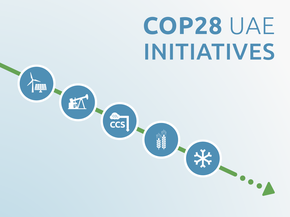Targets
Target Overview
The UAE submitted an updated NDC in July 2023 after having already strengthened its NDC target in 2022. With the UAE’s emissions still set to increase by 2030, we estimate it won’t be able to meet this new NDC target, nor the former one.
The new NDC has an unconditional and economy-wide greenhouse gas emissions reduction target of 182 MtCO2e (including emissions from land use and forestry, or LULUCF) by 2030. The CAT rates this target, excluding LULUCF, as “Almost sufficient” compared to modelled domestic pathways and “Highly insufficient” when compared to the UAE’s fair share. Both ratings have improved from our previous update.
In October 2021 the UAE announced its intention to reach net zero emissions as part of the UAE Net Zero 2050 strategic initiative. As of July 2023, the UAE has yet to submit a long-term strategy to the UNFCCC but it plans to submit one ahead of COP28 according to its latest NDC.
| UAE — Main climate targets |
|---|
| 2030 unconditional NDC target | |||
|---|---|---|---|
| Formulation of target in NDC | Reduce net GHG emissions to 182 MtCO2e (incl. LULUCF) | ||
|
Absolute emissions level in 2030 excl. LULUCF |
185 MtCO2e [6% below 2010] |
||
| Status | Submitted on 11 July 2023 | ||
| Net zero & other long-term targets | |||
|---|---|---|---|
| Formulation of target | Achieve net-zero emissions by 2050 | ||
|
Absolute emissions level in 2050 excl. LULUCF |
N/A | ||
| Status | Announced on 7 October 2021 | ||
NDC updates
The UAE submitted a stronger NDC target to the UNFCCC on 11 July 2023. While the UAE needs to put forward substantially improved climate policies to reach the NDC, it is an improvement on the former one in the following ways:
- It includes strengthened emissions reduction target—to limit emissions to 182 MtCO2e by 2030 (including LULUCF), down from 208 MtCO2e (Government of the UAE, 2023a).
- The target is now expressed as an absolute emissions limit. The previous target was a reduction below a business as usual (BAU) scenario.
- The new NDC provides sectoral targets for the electricity and water generation, industry, transport, buildings, waste and agriculture sub-sectors.
- It includes details of the policies and measures planned to achieve the sectoral targets, a step forward in transparency.
We have estimated this new unconditional target will result in an emissions level of 185 MtCO2e by 2030 (excluding LULUCF), a 14% improvement compared to the previous target of 214 MtCO2e (excluding LULUCF). The target covers all sectors of the economy and major greenhouse gases—CO2, CH4 and N2O. PFCs, sulphur hexafluoride (SF6) and HFCs are not included. However, the UAE is currently preparing a study on these gases as part of its plan to ratify the Kigali Amendment and announced that it will include them in future NDC updates.
This new target represents a targeted decrease in emissions of 13% below 2021 levels (excl. LULUCF).
The NDC mentions many of the policies and strategies that underpin the 2030 target. This includes the UAE’s National Energy Strategy 2050, which aims for 44% of renewable and 6% of nuclear energy in installed electric capacity by 2050, while reducing final electricity demand by 42–45%.
This strategy was recently updated to remove its previous target of 12% of coal capacity by 2050, which is now replaced by an increased fossil gas capacity from 38% to 50%. This updated strategy continues to be inconsistent with the need to reach net-zero CO2 emissions globally by 2050, due to the continued long-term reliance on fossil gas.
The UAE’s new NDC shows an increase in ambition, and has improved its transparency by sharing sectoral targets and more details on the measures planned to achieve them. However, the UAE’s current plans for its oil and gas industry and its power sector continue to be incompatible with its ambition to reach net zero by 2050.
| UAE — History of NDC updates | 2016 NDC | 2020 NDC | 2022 NDC | 2023 NDC |
|---|---|---|---|---|
| 1.5°C compatible |
|
|
|
|
| Stronger target | N/A |
|
|
|
| Economy-wide coverage |
|
|
|
|
| Fixed/absolute target |
|
|
|
|
| UAE | 2016 NDC | 2020 NDC | 2022 NDC | 2023 NDC |
|---|---|---|---|---|
| Formulation of target in NDC |
Unconditional target: Increasing the contribution of clean energy in the total energy mix from 0.2% in 2014 to 24% by 2021. |
Unconditional target: Reduction of 23.5% in GHG emissions for the year 2030, relative to BAU. |
Unconditional target: Reduction of 31% in GHG emissions, measured in CO2e, relative to BAU in 2030. |
Unconditional target: Reduce net GHG emissions to 182 MtCO2e (incl. LULUCF). |
|
Absolute emissions level excl. LULUCF |
Unconditional target: 238 MtCO2e (based on CAT estimate) |
Unconditional target: 246 MtCO2e by 2030 |
Unconditional target: 214 MtCO2e by 2030 |
Unconditional target: 185 MtCO2e by 2030 |
|
Emissions compared to 1990 and 2010 excl. LULUCF |
Unconditional target: 288% above 1990 levels in 2021 21% above 2010 levels in 2021 |
Unconditional target: 301% above 1990 emissions by 2030 26% above 2010 emissions by 2030 |
Unconditional target: 248% above 1990 emissions by 2030 9% above 2010 emissions by 2030 |
Unconditional target: 6% below 2010 emissions by 2030 |
| CAT rating |
Overall rating: Highly insufficient* |
NDC target against modelled domestic pathways: Insufficient NDC target against fair share: Critically insufficient |
NDC target against modelled domestic pathways: Insufficient NDC target against fair share: Critically insufficient |
NDC target against modelled domestic pathways: Almost sufficient NDC target against fair share: Highly insufficient |
| Sector coverage | Energy, Transport and infrastructure, Waste | Economy-wide | Economy-wide | Economy-wide |
| Separate target for LULUCF | No | No | No | Yes. NDC includes LULUCF target to reach -2 MtCO2e |
| Gas coverage | N/A | CO2, CH4, N2O, and PFCs | CO2, CH4, N2O, and PFCs | CO2, CH4, N2O |
| Target type | Renewable energy generation target (no emissions target) | Emissions reduction below BAU scenario | Emissions reduction below BAU scenario | Absolute emissions target |
* Before September 2021, all CAT ratings were based exclusively on fair share and only assessed a country’s target.
Target development timeline & previous CAT analysis
CAT rating of targets
The CAT rates NDC targets against what a country should be doing within its own borders as well as what a fair contribution to achieving the Paris Agreement’s long-term temperature goal would be. For assessing targets against the fair share, we consider both a country’s domestic emission reductions and any emissions it supports abroad through the use of market mechanisms or other ways of support, as relevant.
The CAT rates the UAE's NDC target as "Almost sufficient" when rated against modelled domestic pathways, and "Highly insufficient" when rated against its fair share contribution. The UAE does not specify a conditional target or an international element in its NDC, so we rate the NDC target against the two rating frameworks.
CAT ratings are based on emissions excluding the LULUCF sector. To obtain the NDC emissions level excluding LULUCF, the CAT takes the UAE’s own sectoral target for LULUCF, presented in its latest NDC.
For more details, please see the Assumptions section.
We rate the UAE’s latest 2023 NDC target to reduce emissions as “Almost sufficient” when compared with modelled domestic emissions pathways – up from “Insufficient” under its previous, 2022 NDC. The “Almost sufficient” rating indicates that the UAE’s NDC target in 2030 is not yet consistent with limiting warming to 1.5°C but could be, with moderate improvements. If all countries were to follow the UAE’s approach, warming could be held below—but not well below—2°C.
Our methods do not provide a clear answer as to whether the UAE should provide climate finance. On balance, the CAT methodology shows that the provision of a comparatively small amount of international support is consistent with the wide range of literature on fair share contributions to meeting the Paris Agreement's goals.
We rate the UAE’s latest NDC emissions reduction target from as “Highly insufficient” when compared with its fair share contribution to climate action – up from “Critically insufficient” under its previous, 2022 NDC.
The “Highly insufficient” rating indicates that the UAE’s NDC target in 2030 is not at all consistent with limiting warming to 1.5°C. If all countries were to follow the UAE’s approach, warming could reach over 3°C and up to 4°C.
Further information on how the CAT rates countries (against modelled pathways and fair share) can be found here.
Net zero and other long-term target(s)
The UAE announced its intention to reach net zero by 2050 in October 2021 as part of the UAE Net Zero 2050 strategic initiative. At COP27, the UAE presented its “National Net Zero by 2050 pathway” with further details. In March 2023, the UAE’s member states signed the UAE Governments Net Zero 2050 Charter, further signalling commitment to reaching net zero. As of March 2023, the UAE has yet to submit a long-term strategy to the UNFCCC but it has announced it would do so before COP28.
We evaluate the net zero target as ‘poor’. For the full analysis click here.
Further analysis
Latest publications
Stay informed
Subscribe to our newsletter





